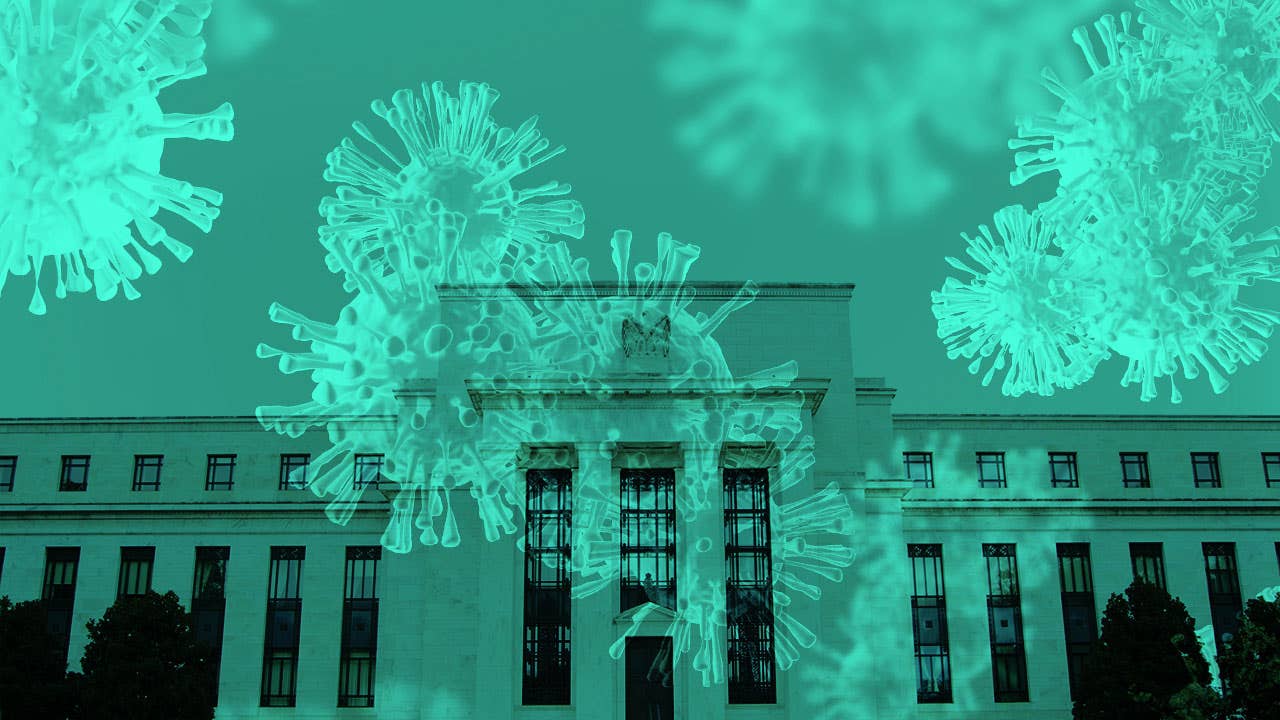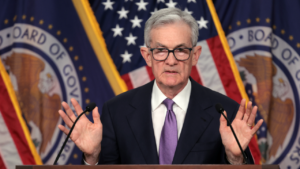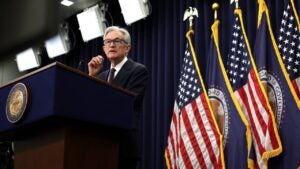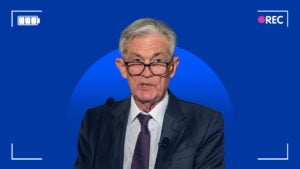Preview of the Fed meeting: What’s left in Powell’s coronavirus recession playbook?

Long before a devastating pandemic would put the global economy through a catastrophic shock, the Federal Reserve started readying its arsenal for the next downturn. But the U.S. central bank’s April meeting highlights a painful irony: The coronavirus crisis came along before officials had fully prepared.
Fed policymakers were only a few months away from announcing the results of a broad toolkit review – a massive Fed-wide undertaking that had engulfed policymakers’ time since November 2018 and could’ve changed the way the U.S. central bank responds to downturns – when a contagious, novel coronavirus started spreading throughout the world.
Up until March, it was generally a good time to be a Fed official: Inflation was tame, and unemployment was at its lowest levels since the 1960s. Then state orders forced businesses to shutter and consumers to stay at home to help curb the pathogen’s spread.
It’s sent the economy spiraling down what could be the worst economic crisis since the Great Depression, and it’s been an uncomfortable lesson for Fed officials: Although downturns are preparable, they are not predictable. Now, for the first time since the Great Depression, officials on the Federal Open Market Committee (FOMC) are meeting at a time when more than 26 million Americans have filed for unemployment.
“Make sure as little as possible breaks on the way down,” says Vincent Reinhart, a former Fed staffer who is now chief economist and macro strategist at Mellon, of the U.S. central bank’s most pressing job right now. During recessions, “businesses fail, balance sheets deteriorate. The Fed right now has got to try to keep as much traffic on the road as possible, because it’s the crash that makes the rebounds look less vigorous.”
These themes – and more – are what Fed officials will have confronted by the time their next two-day meeting concludes in Washington on April 29. Here are four key questions facing the Fed and what they mean for you.
1. What more can the Fed do?
But it’s not as if the unfinished framework review has held the Fed back. Since March 3, officials have moved at lightning speed, slashing interest rates to zero, eliminating reserve requirements for banks that hold money at the Fed, creating swap lines with other central banks around the world and instituting an unprecedented, unlimited bond-buying program.
Officials have also created 11 different emergency lending facilities – some taken from the 2008-crisis era playbook and others formed entirely from scratch in coordination with the Treasury Department. At one point, the Fed was announcing a new program every 18 hours, according to an analysis from Reinhart.
Fed Chair Jerome Powell has reiterated that the powder is dry. He said in an April 9 Brookings Institution webinar that the Fed stands ready to act “forcefully, proactively, and aggressively” to curb the fallout.
But with officials forthright about their reluctance to cut into negative territory, there’s nowhere else for the Fed’s benchmark interest rate to go. That means it’ll be worth watching whether officials announce any new facilities or expand its existing programs, either in size or by accepting more collateral.
Theoretically, the Fed’s “lender-of-last-resort” powers are only limited by how much the Treasury Department is willing to give as a backstop.
Watch for whether the Fed announces or mentions plans to help mortgage servicers
Nonbank mortgage servicers are a critical corner of the financial system the Fed has yet to dip its toes in.
The Mortgage Bankers Association joined a chorus of voices – including Rep. Maxine Waters, a Democrat from California, who chairs the House Financial Services Committee – that have called on the Fed and the Treasury to develop a liquidity facility specifically for these firms. With millions out of work and businesses closed, a tsunami of missed payments has left servicers in a severe cash crunch that could strain a large swath of the mortgage industry.
Powell said during the Brookings webinar that the Fed is watching the situation. If the Fed were to announce any kind of new emergency program, it’d likely be designed for them, says Roberto Perli, partner at Cornerstone Macro and a former Fed economist.
Fed officials may also find that helping nonbank mortgage lenders is more up the Federal Housing Finance Agency’s (FHFA) alley, says Greg McBride, CFA, Bankrate chief financial analyst.
With people skipping payments, mortgage servicers are stuck between a rock and a hard place because they need money to pay investors who own bonds backed by the loans. The FFHA announced Tuesday firms will have to make just four months of cash payouts to bond investors, with Fannie Mae and Freddie Mac assuming obligations after that.
But other Fed watchers highlight that it’s important to get the existing catalog of programs up and running before venturing into even newer territory. Just three of the Fed’s 11 facilities – its Commercial Paper Funding Facility (CPFF), Primary Dealer Credit Facility (PDCF), Paycheck Protection Program Liquidity Facility – are fully operational.
“The job now is execution,” says Bill English, finance professor at the Yale School of Management who spent nearly 20 years at the Fed. “They have a huge amount of work to do to roll out these programs they’ve announced.”
Aside from flooding the markets with extra liquidity, the Fed could also explore purchasing different types of assets, including longer-term securities and a broader range of municipal securities, though the Fed has been reluctant to dip into the latter for political reasons. Fed governor Lael Brainard also floated an idea last fall of targeting the yield curve.
2. How long will near-zero rates be around for?
Another powerful tool that the Fed can use is interest rate communication. A heads up about where rates are going and how long they’re going to be there – a process experts often call “forward guidance” – is an important way the Fed can guide expectations.
So far, Powell and Co. have emphasized that rates will hold at near-zero until the Fed is “confident that the economy has weathered recent events and is on track” to reach its twin mandate of full employment and 2 percent annual inflation.
Officials in March might not have wanted to be more specific at the time, given that the virus’ outlook was uncertain. But even though more data is yet to be released, the Fed isn’t aiming blindly anymore. The March jobs report showed a steeper-than-expected plunge in payrolls, while initial jobless claims show that millions are out of work. Experts say it may be time for the Fed to provide a more precise picture of what matters most.
What the Fed has said so far is “fairly weak forward guidance,” Perli says. “It’s open to interpretation. But what do you need to see in order to raise rates? Just the virus going away or being controlled, or do you put more weight on unemployment and inflation coming back to levels consistent with your target? In that case, it could be years and years.”
3. How well are the Fed’s emergency responses working?
The most significant part of the Fed’s response to the coronavirus hasn’t been on the interest rate front, but on flooding the financial system with credit, McBride says. Its importance is simpler than you think: It doesn’t matter if interest rates are low if it’s impossible to get a loan.
“Credit is the lifeblood of an economy,” McBride says. “An economy starved of credit is like a fire starved of oxygen.”
It’s hard to judge exactly how successful the Fed has been, simply because officials haven’t yet flipped the “on” switch for most of its programs. But even the mere sentiment of providing the financial system with support has helped calm jittery markets. Equities have for the most part rebounded since March 23, when the Fed first announced a series of sweeping steps to help the economy.
“They are improving sentiment, and that has had an effect on the willingness of investors to take on risk,” Perli says. “The Fed has done that intentionally, but I think eventually and hopefully soon, they will have to translate words into actions.”
4. Will the Fed’s unprecedented programs become permanent?
The Fed’s programs are wide-reaching, but they don’t include everyone. Cities with less than one million residents and counties with populations of less than two million residents, for example, are excluded from the Fed’s Municipal Liquidity Facility – a design sure to leave sizable swaths of the country behind.
“Every time you have an intervention, you’re going to help someone more than others,” Perli says. “The only solution to that problem is that the Fed buys the whole market, but none of that is desirable. The Fed cannot buy everything in sight.”
Those squeezed out of the program could still gain access to funds. Some entities could gobble up the loans and be responsible for trickling those funds down to the counties that need them most, English says.
But experts say the narrow design is intentional. It’s hard to wean the financial system off of a program once it’s announced, and even harder to prove you don’t have to implement it in another crisis.
Case in point: Quantitative easing (Q.E.). It was unusual and controversial when the Fed first used it in 2008. Now it’s become a mainstay for the Fed’s recession response.
“Once you cross the line, it’s hard to cross it back the other way,” Perli says. “It’s going to be hard to not do the same thing again, if or when there’s going to be another crisis. That doesn’t mean it’s necessarily bad – it’s the right thing to do when you have a crisis like this one. But this doesn’t mean that the Fed is going to buy corporate bonds as its regular business.”
Still, many Fed watchers point out that there wouldn’t be a future worth worrying about it, if the U.S. central bank were to limit its policy response.
“This is an unprecedented economic stop, so the response has to be equally unprecedented,” McBride says. “The one lesson that the Fed has learned, particularly from the financial crisis, is it’s better to think big than to limit your response.”
What this means for you
Understanding how an interest rate cut impacts everyday people is hard enough. Throw in a confusing slew of liquidity facilities in the mix, and it may seem like rocket science. But while Congress’ response to the coronavirus has revolved around helping everyday people get by, you can think of the Fed’s playbook as ensuring the recovery is as vigorous as possible.
An economy flooded with liquidity should, in theory, help banks free up their balance sheets to lend out more. That cycles back into your pocketbook eventually. It increases access to mortgages and ensures that large companies can continue making payroll and purchasing inventory.
“The various liquidity programs are absolutely critical to keep markets functioning and prevent an even-worse economic outcome,” McBride says. “If you’re stuck holding a loan, you’ve got no liquidity to make the next loan.”
Right now, it’s best to prioritize building up your emergency savings, even more so than paying off high-cost credit card debt, McBride says. If your income has been disrupted, it’s OK to pay the minimum payment on a balance, he says. The future is on shaky ground.
“If you’re lacking significant emergency savings, you can put the debt repayments on hold to pad your cushion because no one knows what lies ahead,” he says. “Everybody’s life and routine has been forcibly altered due to the pandemic, and we can all see with our own two eyes the significant economic fallout.”
Yale’s English expects that once the coronavirus uncertainty is mostly in the rearview mirror, officials will announce the results of their framework review. But it doesn’t take away the sting of the recession coming at a terrible time.
Then again, most recessions do.
“It would’ve been great to have been able to announce it in peacetime,” he says. “Having not been able to do that, they are in a little bit of a bind. But they still benefit from having thought through these issues, as they use that thinking to plan monetary policy over the next year or two.”
Learn more:
- List of banks offering help to customers impacted by the coronavirus
- 5 ways coronavirus could change your next home purchase
- Stimulus checks: What consumers should consider doing with the money
Why we ask for feedback Your feedback helps us improve our content and services. It takes less than a minute to complete.
Your responses are anonymous and will only be used for improving our website.






